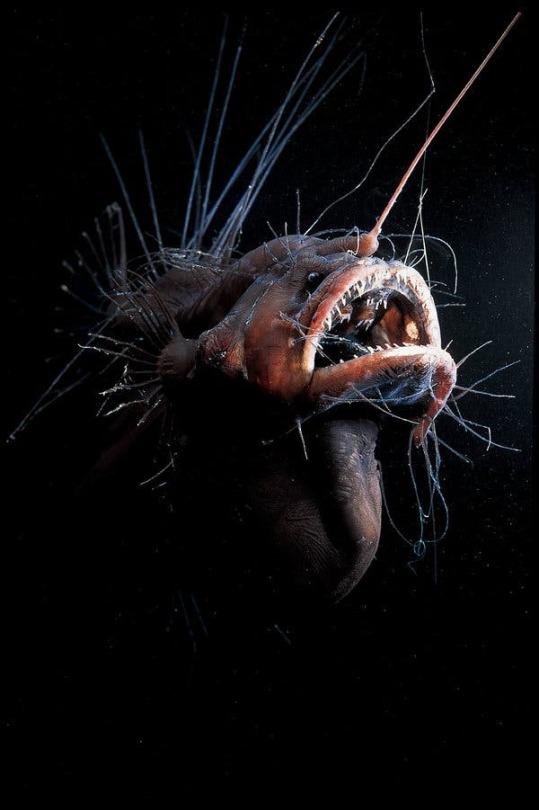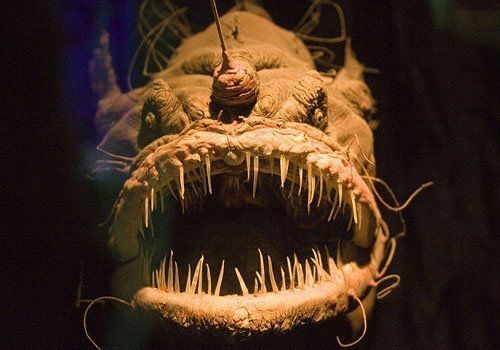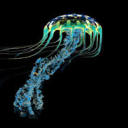Basket Star


Basket Star
Gorgonocephalus caputmedusae
The Basket Star is a strange yet elegant creature that lives in the deep ocean. It resembles a flesh white ball with gnarled and swirling branches. It thrives in locations with strong currents. Its numerous arms move slowly and wrap around prey. They are one of my favorite animals from the Echinodermata phylum.
Photo credit
https://link.springer.com/article/10.1007/s00227-005-0032-3
https://en.wikipedia.org/wiki/Gorgonocephalus
More Posts from Bioluminescentoceangoddess and Others


Jewel Squid
Histioteuthis heteropsis
The Jewel Squid is covered in color-changing photophores that resemble sparkling gem stones. They also have a light-red coloration and are about 20 cm in length. They display a unique behavioral adaptation called diel migration. During the day, they stay at depths around 400-1200 m, and then surface during night (0-400m). This behavioral pattern is designed maximize feeding at night, and avoid predators during the day. The primary predator of the Jewel Squid is the Sperm Whale.
Photo credit: https://www.pinterest.com/pin/722827808920240115/
https://twitter.com/theoctonation/status/1168516522270253056

Predatory Copepod
Paraeuchaeta barbata
Copepods are a type of zooplankton or tiny creature that feeds larger animals in the ocean such as, fish. They are crustaceans that have two long antennas and a sensory eye called an ocelli, which can only sense light. This copepod is located between 200m to 1500 m in the deep ocean. You may notice the copepod is red in color. The color is an adaptation that makes it difficult for predators to see the copepod because red wave lengths do not penetrate this depth (mostly blue and indigo light). Even though this creature tiny, it is a vital food source for many animals in the abyssal zone of the ocean.
Photo credit: http://www.arcodiv.org/watercolumn/copepod/Paraeuchaeta_barbata_large.html


Blacksnout Seasnail
Paralipparis copei copei
The Blacksnout Seasnail may not look like a snail, but it does have a slimy, gelatinous substance that covers its body. It can be found at depths between 200 m to 1692 m, and adults grow up to be 17 cm in size (approximately 6.5 in). It also has an elongated body that resembles an eel. Furthermore, it can be seen rolling itself in a loop; this behavior is a defensive posture that makes it appear like a jelly. In the darkness, predators tend to avoid the Blacksnout Seasnail because its often mistaken as a hunter due to its appearance and behavior.

Crystal Jellyfish
Aequorea victoria
The Crystal Jellyfish is a graceful, transparent jellyfish with long, thin tentacles. It has bioluminescent organs around it bell that produce a bright, green light. It tends to consume small copepods, but it has the ability to swallow other jellyfish half its size. Furthermore, this jelly is used in biological experiments to detect calcium.
Photo credit: https://www.montereybayaquarium.org/animals/animals-a-to-z/crystal-jelly
https://fineartamerica.com/featured/5-aequorea-crystal-jellyfish-with-amphipods-alexander-semenovscience-photo-library.html
Dear ocean enthusiast and supporters,
Hi everyone, thank you for supporting my blog. I have gained over 500 followers and that is worth celebrating. I will try my best to post every day some of the amazing creatures that live in the deep ocean. Have a great night!
Sea sparkle is a common, bioluminescent plankton. Even though its not an animal, it is worth sharing.


Sea sparkle
Noctiluca scintillans
Sea sparkle is a bioluminescent dinoflagellate that blooms in many coastal waters. Sea sparkle feeds on plankton, diatoms, fish eggs, and other dinoflagellates. It also has a flagellum, or tiny tail, that helps it move around in the water. Even though sea sparkle is beautiful to witness at night, it is hazardous to other marine species and resembles a reddish-pink film during the day.
Photo credit:
https://alexandrathemb.tumblr.com/post/49814932878/noctilucas-scintillans-a-bioluminescent
https://thevelv.blogspot.com/2015/07/noctiluca-scintillans.html



Black Dragonfish
Idiacanthus atlanticus
The Black Dragonfish are needle-like fish that migrate between 500m and 2000m in the deep ocean. Females are black with 6 stripes and lack a barbel, pelvic fins, and sharp teeth. Males, on the other hand, are dark brown and have a barbel, which is the light producing structure on its chin. Furthermore, it uses bioluminescence to detect prey instead of lure prey.
Photo credit: https://scitechdaily.com/scientists-learn-secrets-from-ultra-black-skin-that-allows-deep-sea-fish-to-lurk-unseen/
https://steemit.com/life/@munnashah/the-most-terrible-and-surprising-7-animals-of-the-sea
https://knowyourmeme.com/photos/995601-thalassophobia


Fanfin Seadevil
Caulophyyne jordani
The Fanfin Seadevil is an ugly, deep fish that is covered in gnarled skin and long sensory filaments. The sensory filaments allow this species of anglerfish to detect movement in the water; this helps the Fanfin find and lure its prey. Furthermore, this deformed monstrosity can be found floating between 700m to 3000m in the ocean.
Photo credit: https://www.nytimes.com/2019/07/29/science/anglerfish-bioluminescence-deep-sea.html
http://www.robotspacebrain.com/alien-creatures-of-the-mariana-trench/

Marrus orthocanna
Marrus orthocanna is a deep sea siphonophore found at depths between 400m to 2200m. It has a colony of gas-filled zooids on the top used for locomotion. It also has a long, bright orange tentacles on the bottom. Marrus orthocanna are viscous predators and consume small crustceans and copepods.
Photo credit: http://www.arcodiv.org/watercolumn/cnidarian/Marrus_orthocanna.html


Pacific Viperfish
Chauliodus macouni
The Pacific Viperfish looks intimidating with its sharp, pointy teeth and large jaws. However, its body is small and elongated. It can be found at depths ranging from 250m to 4390m. The Pacific Viperfish long teeth are an unique adaptation designed to keep prey trapped, but it is dangerously close to its eyes. There have been instances when they have caught prey that are too large to swallow and it dies along with its last meal. The Pacific Viper also has photophores along its body and a light organ near its dorsal fin. These organs exhibit bioluminescence and help with attracting pray: as well as, communicating with mates and confuse predators. It is one of the most ferocious predators of the deep ocean.
Photo credit: https://www.science-rumors.com/top-20-pacific-viperfish-facts-to-know-what-this-creature-is/
https://goldfisho.com/everything-you-need-to-know-about-viperfish/
-
 moristyle reblogged this · 7 months ago
moristyle reblogged this · 7 months ago -
 lichengender liked this · 8 months ago
lichengender liked this · 8 months ago -
 faultyconnection-error2981046 liked this · 8 months ago
faultyconnection-error2981046 liked this · 8 months ago -
 yeasayers reblogged this · 1 year ago
yeasayers reblogged this · 1 year ago -
 graceful-worm liked this · 1 year ago
graceful-worm liked this · 1 year ago -
 chillywillow1 reblogged this · 1 year ago
chillywillow1 reblogged this · 1 year ago -
 chillywillow1 liked this · 1 year ago
chillywillow1 liked this · 1 year ago -
 bug-bytes liked this · 1 year ago
bug-bytes liked this · 1 year ago -
 blackhelms-helmets reblogged this · 1 year ago
blackhelms-helmets reblogged this · 1 year ago -
 blackhelms-helmets liked this · 1 year ago
blackhelms-helmets liked this · 1 year ago -
 betttya liked this · 1 year ago
betttya liked this · 1 year ago -
 the-sith-in-the-sky-with-diamond reblogged this · 1 year ago
the-sith-in-the-sky-with-diamond reblogged this · 1 year ago -
 the-sith-in-the-sky-with-diamond liked this · 1 year ago
the-sith-in-the-sky-with-diamond liked this · 1 year ago -
 ladykagewaki liked this · 1 year ago
ladykagewaki liked this · 1 year ago -
 guestiguess reblogged this · 1 year ago
guestiguess reblogged this · 1 year ago -
 guestiguess liked this · 1 year ago
guestiguess liked this · 1 year ago -
 vicious-glitter liked this · 1 year ago
vicious-glitter liked this · 1 year ago -
 wonda-ch liked this · 1 year ago
wonda-ch liked this · 1 year ago -
 just-a-tiny-goldfish reblogged this · 1 year ago
just-a-tiny-goldfish reblogged this · 1 year ago -
 a-shimmering-tear liked this · 1 year ago
a-shimmering-tear liked this · 1 year ago -
 electronicdreamerdreamer liked this · 1 year ago
electronicdreamerdreamer liked this · 1 year ago -
 pearlyscales reblogged this · 1 year ago
pearlyscales reblogged this · 1 year ago -
 klubcrush reblogged this · 1 year ago
klubcrush reblogged this · 1 year ago -
 weather-mood reblogged this · 1 year ago
weather-mood reblogged this · 1 year ago -
 chaos-fae-systems liked this · 1 year ago
chaos-fae-systems liked this · 1 year ago -
 hammer-head-shark liked this · 1 year ago
hammer-head-shark liked this · 1 year ago -
 wonderlandifulcat liked this · 1 year ago
wonderlandifulcat liked this · 1 year ago -
 abinfleetin liked this · 1 year ago
abinfleetin liked this · 1 year ago -
 stardustandmoonflowers liked this · 1 year ago
stardustandmoonflowers liked this · 1 year ago -
 burnothing reblogged this · 1 year ago
burnothing reblogged this · 1 year ago -
 despasito liked this · 1 year ago
despasito liked this · 1 year ago -
 whiteshipnightjar liked this · 1 year ago
whiteshipnightjar liked this · 1 year ago -
 krowepoison liked this · 1 year ago
krowepoison liked this · 1 year ago -
 besnail reblogged this · 1 year ago
besnail reblogged this · 1 year ago -
 braindamagelesbian reblogged this · 1 year ago
braindamagelesbian reblogged this · 1 year ago -
 noaffence reblogged this · 1 year ago
noaffence reblogged this · 1 year ago -
 noaffence liked this · 1 year ago
noaffence liked this · 1 year ago -
 alpacaoverlord reblogged this · 1 year ago
alpacaoverlord reblogged this · 1 year ago -
 idontunderstandjelly reblogged this · 1 year ago
idontunderstandjelly reblogged this · 1 year ago -
 pinkbalrog reblogged this · 1 year ago
pinkbalrog reblogged this · 1 year ago -
 pinkbalrog liked this · 1 year ago
pinkbalrog liked this · 1 year ago

Bioluminescence is a chemical reaction that produces light. Many deep sea animals use bioluminescence. This blog is dedicated to educating the public about the amazing creatures that thrive in the deep sea.
57 posts